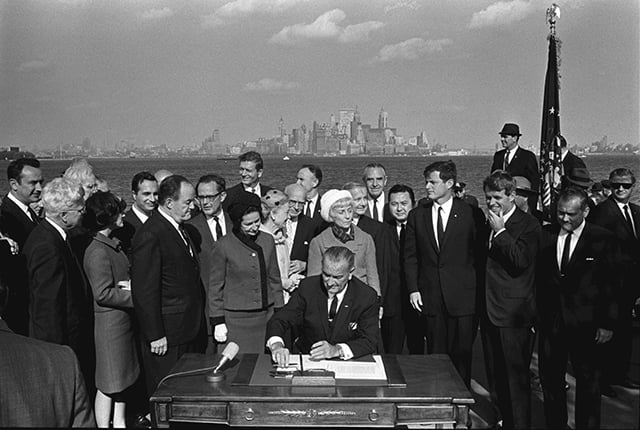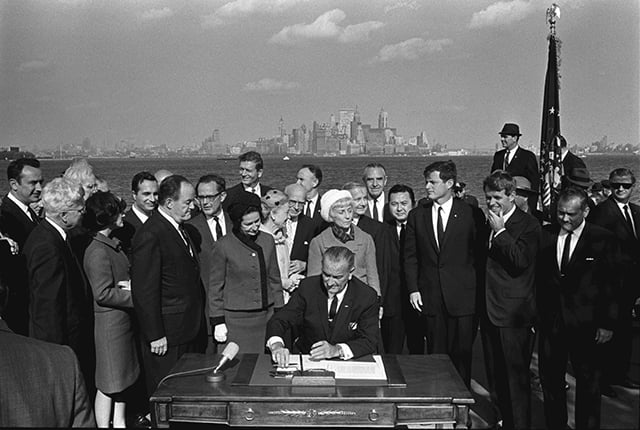
 President Lyndon B. Johnson signs the Immigration Act as Vice President Hubert Humphrey, Lady Bird Johnson, Muriel Humphrey, Sen. Edward (Ted) Kennedy, Sen. Robert F. Kennedy and others look on, at Liberty Island, New York, October 3, 1965. (Photo: LBJ Presidential Library)
President Lyndon B. Johnson signs the Immigration Act as Vice President Hubert Humphrey, Lady Bird Johnson, Muriel Humphrey, Sen. Edward (Ted) Kennedy, Sen. Robert F. Kennedy and others look on, at Liberty Island, New York, October 3, 1965. (Photo: LBJ Presidential Library)
October marks the 50th anniversary of the passage of the 1965 Immigration and Nationality Act, which President Lyndon B. Johnson signed into law at a public ceremony held at the base of the Statute of Liberty. The act is rightly celebrated for dismantling the infamous “national origins” quota system that gave special preference to immigrants from Western Europe while effectively barring newcomers from Asia and severely curtailing immigration from Southern and Eastern Europe. While the egalitarian ethos of the 1965 law is often hailed as a civil rights victory, its legacy is far more complex.
Whether intentional or not, the law spurred a major shift in the demographic character of the immigrant population over the past half-century. The sweeping changes ushered forth by the law were set into motion by shifting Cold War geopolitical configurations. The United States emerged from World War II as the uncontested leader of the “free world” and locked in a global rivalry with the Soviet Union and China for the hearts and minds of the world’s population.
The liberalization of US immigration policy can trace its roots to the period of national self-examination following World War II. The explicit use of racial and ethnic selection in public policy was widely discredited in the aftermath of the war due to its association with the Nazi regime. The ignominious legacy of Japanese internment, moreover, served as a cautionary tale about the perils of state-sanctioned racial chauvinism.
US policy makers launched a postwar campaign to bolster ties with Asian countries and contain the spread of communism in the region. These efforts were undercut by the persistence of exclusionary immigration policies that barred Asians as “racially undesirable.” US officials worked to address charges of systemic discrimination as part of a larger geopolitical strategy designed to rehabilitate the United States’ global image by resolving the glaring incongruity between the herrenvolk democracy practiced at home and the egalitarian principles the United States promoted overseas.
While the postwar political climate was favorable, the road to reform did not follow a straight path. The McCarran-Walter Act passed in 1952 married old-line restrictionist thinking with Cold War paranoia about the infiltration of “subversives.” The act allocated 85 percent of the nation’s immigration slots to Western and Northern Europeans and implemented new provisions to exclude and deport suspected radicals. President Harry S. Truman vociferously campaigned against the bill, arguing that its extension of the national origins quota system harmed the foreign policy interests of the United States, but Congress easily overrode Truman’s veto. The McCarran-Walter Act’s allocation of a meager quota of 100 immigration slots per year to the so-called “Asia-Pacific Triangle” underscored the continuing salience of racial anxieties, which became more pronounced as the United States projected its military power abroad to contain the spread of communism in Asia.
The standoff between the executive branch and Congress regarding immigration policy would be a recurring conflict throughout the early Cold War period. Officials from the White House and State Department increasingly viewed the selection regime that excluded people based on ascribed attributes (e.g. ethnicity, nationality) as a political liability that undermined the moral standing of the United States at a time when anti-colonial politics were sweeping across the developing world.
Decisions about who to admit into the United States is as much about foreign policy as it is domestic policy.
A series of refugee crises during the 1950s involving population groups fleeing communist regimes (e.g. Hungarians, Chinese, Cubans) created pressure to open the nation’s doors to the uprooted. Political fissures in Congress, however, impeded executive branch efforts to overhaul the nation’s immigration regime. Consequently, President Truman used executive orders to circumvent Congress – a tactic continued by the Eisenhower and Kennedy administrations, which also wielded emergency “parole powers” authorized under the McCarran-Walter Act to admit large numbers of displaced persons outside restrictive quota limits.
Geopolitical turmoil provided an opportunity for reformers to outflank isolationists. Liberals employed the language of human rights to paint restrictive immigration laws as damaging to the moral standing of United States. How, they asked, could the US denounce communism as a “totalitarian system,” yet not open its borders to those fleeing communist regimes? Over the next decade, presidential parole powers were used to admit tens of thousands of Hungarian, Chinese, Korean and Cuban refugees, with little opposition from Congress, setting the stage for more wholesale changes to the management of US borders.
By the early 1960s, a broad coalition of domestic groups including ethnic organizations, church associations and labor unions threw their weight behind the campaign to abolish the national origins quota system. John F. Kennedy, first as a senator and then as president, emerged as the nation’s most high-profile proponent of reform. Kennedy worked closely with Jewish-American leaders, publishing the influential volume, A Nation of Immigrants, which set out to reframe the immigration debate by highlighting the myriad contributions of immigrants to US society. Kennedy portrayed admissions policy rooted in ethnic and national discrimination as incompatible with the spirit enshrined in the Declaration of Independence that “all men are created equal.”
Kennedy’s assassination temporarily delayed the push for reform, but the Johnson administration would eventually embrace overhauling the immigration system as a key part of its civil rights agenda. Reformers like Rep. Emanuel Celler, Assistant Secretary of State for Security and Consular Affairs Abba Schwartz and labor leader George Meany turned the tables on isolationists, repurposing Cold War rhetoric to boost the case for liberalization. They argued that defenders of the national origins schema unwittingly embraced the enemy’s ideology by espousing a form of “collectivist” thinking that judged people as undifferentiated members of ethnic and national groups rather than as individuals. An immigration system that excluded people based solely on group membership, liberals asserted, was incompatible with the US democratic tradition, which venerated individual rights as an elemental property of citizenship in the republic.
Large Democratic majorities installed during the 89th Congress and changes to the congressional committee structure bolstered the campaign for immigration reform.
The Immigration and Nationality Act of 1965, also known as the Hart-Celler Act, proposed a new admissions system organized around “preference categories” that prioritized family reunification and high-skilled labor. Warnings from conservatives that eradicating the national origins system would lead to a flood of “unassimilable” Asian immigrants sought to tap into latent anxieties about racial encroachment. Reformists downplayed these concerns, noting that the bill’s emphasis on family reunification would not significantly benefit Asians, since they made up less than 1 percent of the US population at the time. As the measure moved toward a vote, restrictionists proposed an amendment imposing an annual quota limit on immigration from the Western Hemisphere, which, up to this point, had never been subject to numerical restriction. While the Johnson administration viewed this proviso as harmful to US relations with Latin America, it was forced to concede on this issue to get the legislation passed.
The new system established annual quotas of 170,000 for the Eastern Hemisphere and 120,000 for the Western Hemisphere, nearly doubling the number of visas granted under the previous system. The majority of visas (74 percent) were allocated to family reunification categories. Twenty percent went to employment-based categories, and the remaining 10 percent were reserved for refugees.
Two unintended consequences of the 1965 act are among its most enduring legacies. The first is the dramatic increase in Asian immigration to the United States. The percentage of Asians entering the country increased dramatically over the first two decades of the law. This is largely attributed to the phenomenon of “chain migration,” whereby a US resident sponsors family members, who in turn sponsor their kin. The increase is also a consequence of US military interventions in Asia that spurred the arrival of “war brides,” Korean orphans and refugees from Southeast Asia.
The 1965 act’s implementation of Western Hemisphere quotas also dramatically altered the character of Latino immigration to United States. By curtailing the supply of Mexican labor migration to the US Southwest at a time when demand for service and unskilled labor remained high, the law occasioned a precipitous rise in undocumented immigration across the Southern border. Efforts to stem the circular flow of migrant labor over the past five decades via punitive enforcement have been ineffectual and unintentionally led to an increase in the population of Latinos living in the United States, since labor migrants are now more likely to stay permanently in the country and plant roots rather than risk a return trek across the border gauntlet.
Two key lessons from the 1965 act can help to guide current debates about comprehensive immigration reform. The first is that decisions about who to admit into the United States is as much about foreign policy as it is domestic policy, and that the United States’ overseas entanglements have repeatedly spurred migration to the US. For example, roughly 50,000 Iraqi refugees have been admitted to the United States since the early 1990s largely as a result of US military intervention in the region.
More recently, US efforts to topple the Assad regime in Syria and the subsequent campaign to combat ISIS in the region have contributed to the displacement of more than 4 million Syrians. The Obama administration, following in the footsteps of previous presidents, has announced that it plans to use its emergency parole powers to admit at least 10,000 Syrian refugees next year and possibly increase that number as conditions warrant.
The second lesson is that an immigration system that fails to harmonize admissions criteria and domestic labor market demands is likely to produce dysfunctional results. There are an estimated 10-12 million undocumented immigrants living in the United States who perform labor that is vital to the US economy. Implementing an earned-legalization program for these migrants and their children would benefit the United States by bringing in new tax revenue streams and would allow the Mexican immigrant population to come out of the shadows and become fully vested members of US society. The prospects for a comprehensive immigration bill that might regularize the status of the undocumented population, however, remains in limbo as Republicans double down on the failed militarized border policy of the past 30 years.
Join us in defending the truth before it’s too late
The future of independent journalism is uncertain, and the consequences of losing it are too grave to ignore. To ensure Truthout remains safe, strong, and free, we need to raise $31,000 in the next 48 hours. Every dollar raised goes directly toward the costs of producing news you can trust.
Please give what you can — because by supporting us with a tax-deductible donation, you’re not just preserving a source of news, you’re helping to safeguard what’s left of our democracy.